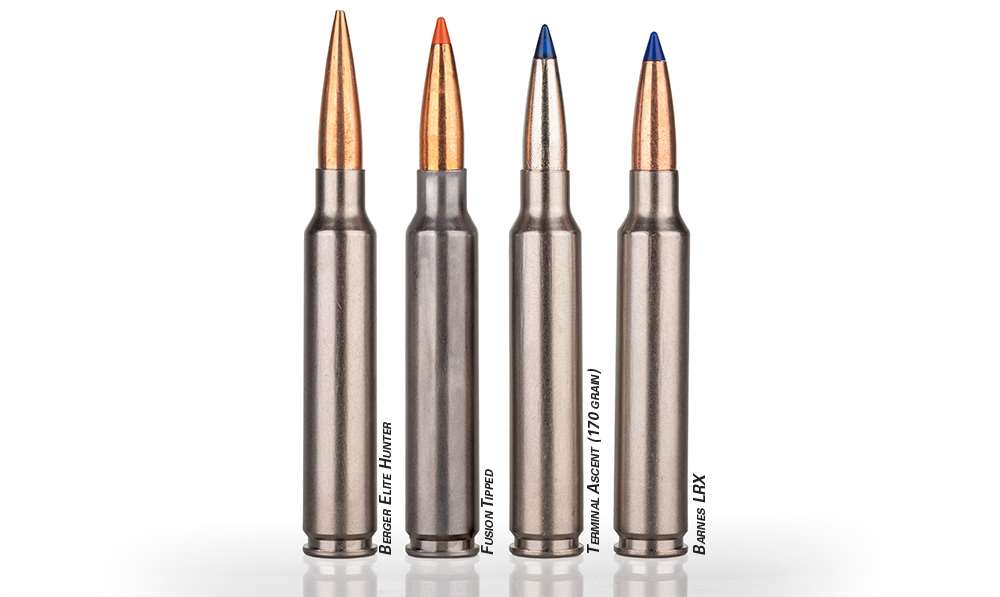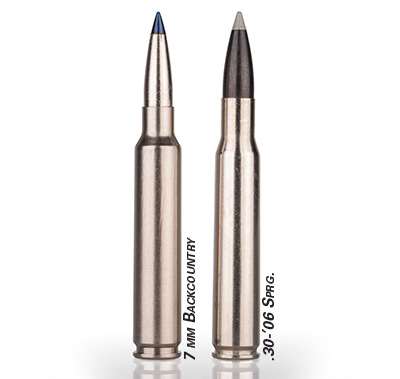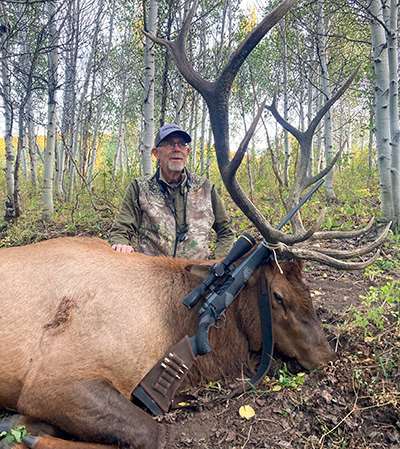Newly introduced cartridges that American Rifleman receives for testing and evaluation normally come with summaries of their unique virtues, but that was not the case when our insider at Federal Ammunition called with an invitation to join him on a Utah elk hunt, where, by the way, we would be shooting the new 7 mm Backcountry. Beyond the name—which, of course, evokes hunting—the only information provided was that the newcomer “… will do the job at all practical ranges,” with no further details provided as to what tasks that might entail, let alone ballistic statistics or technological breakthroughs. In fact, no marketing hype whatsoever was offered. So, as enthused as I was about going elk hunting again, the invitation was akin to getting hooked up on a blind date for the prom.
Samples that arrived shortly before the hunt bore the generic head stamp “FC 24” and were simply labeled: “3000 fps [muzzle velocity] w/20″ barrel” and “G1: 0.645 … G7: 0.325 [ballistic coefficient].” Also listed was the payload, Federal’s top-of-the-line Terminal Ascent. At 170 grains, it’s a tad lighter than the heavyweight 175- and 180-grain premium projectiles loaded in presumptive competitors such as Hornady’s 7 mm PRC and 28 Nosler. The cartridge profile was also a surprise. Expecting a trendy fat-bodied case with an inch of bullet protruding from the mouth, I found—at first glance—what sure looked like a .280 Rem. Upon closer inspection, the new 7 mm BC was a hair stouter than the 67-year-old Remington number, their respective body tapers measuring 0.4698″ to 0.4581″ vs. 0.470″ to 0.442″. The old-timer’s case length is 0.13″ longer, but since the newcomer’s neck is shorter and its 30-degree shoulder more gradual, potential powder capacity to the base of the shoulder is quite comparable.
Those specifications gave me an idea of what to expect from the 7 mm Backcountry. I calculated that it would outpace the .280 Rem. and .280 Ackley Imp. by 150 to 200 f.p.s. of muzzle velocity, shoot almost 2″ flatter at 500 yards than the 7 mm PRC and hurl its hyper-efficient Terminal Ascent projectiles to knockdown energies close to 7 mm-bore monster magnums. On paper, the Backcountry was outpunching its weight class by a lot.
Federal CEO Jason Vanderbrink (right) discusses the 7 mm Backcountry cartridge with Utah father/son outfitters Travis and Kayden Murphy (l. & center) after successfully downing a record-book mule deer buck at long range. Photo by author.
Armed with a Weatherby Mark V Live Wild test rifle, off to the range I went to forge a working familiarity that would prepare me for the serious business of shooting a bull elk. Before I could even finish zeroing, the fellow at the next bench asked, “What is that? Real banger, eh?” Actually, the recoil didn’t seem so bad. “It’s, uh, a 7 mm wildcat,” I dodged. “Guess the short barrel makes it bark.” But insofar as the downrange bite, he was right.
At first, the carbine-size Weatherby deviated between promising clusters and unwanted fliers. After 30 rounds, it settled down nicely and fired a couple near-minute-of-angle five-shot groups. With my supply dwindling, I reserved a box for practice from field positions, a session that concluded with the encouraging abuse of a 250-yard gong from prone and sitting. Not the most extensive run-up, but since the bugle season would be in full-throat, I hoped for cooperative elk.
Before that could happen, though, I’d meet up with hosts from Federal and finally learn more about the new cartridge and what nuances I might have overlooked. Turns out, I had gleaned little about what really makes the 7 mm Backcountry tick. I was pulling the trigger on what could prove to be a huge milestone in firearm and ammunition development and hadn’t even realized it.
Better Metal
To cut to the chase, I’ll admit to using the wrong tools to unlock its secrets. Rather than a digital caliper, reloading scale, chronograph and downrange targets, I should’ve begun with a magnet. With that clue, now you know, too. The cartridge case is steel, or, more specifically, a trade-secret steel alloy reportedly already in demand in various industrial categories. It is not material previously used for ammunition but is highly suited to that job, according to Federal rifle ammunition Managing Engineer Jake Burns. “[Where] brass cases are largely containers for propellant and it’s the gun really managing all the pressure, the Peak Alloy case (a trade name), acts as its own mini pressure-containment vessel, absorbing some of the energy without cracking or stretching. That’s part of the case’s ability to manage pressure,” he explained.
Clearly it behaves unlike brass, and don’t confuse it with the bargain steel-case loads imported from Eastern Bloc factories going back to Cold War times, which could be counted on to be brittle, hard to cycle, rust-prone and inconsistent. Or even with better steel-case ammunition such as the U.S. ordnance loaded by Chrysler during World War II or Hornady’s Steel Match line from the 2010s. Of course, in 2020, after entry in U.S. military trials for a Next Generation Squad Weapon (NGSW), SIG introduced its 6.8×51 mm CC/.277 Fury, a new hybrid cartridge whose complex case combines a steel head joined by an aluminum locking washer to a brass body.
 This time, the world’s largest ammunition manufacturer is going all-in on a next-generation ferrous case, albeit a one-piece, monometal unit. That news from Burns on the drive to camp shouldn’t have been surprising in the wake of SIG’s invention, and the light bulb really clicked on in my head when he added, “… at 80,000 p.s.i.”—the same range of chamber pressure at which the .277 Fury operates.
This time, the world’s largest ammunition manufacturer is going all-in on a next-generation ferrous case, albeit a one-piece, monometal unit. That news from Burns on the drive to camp shouldn’t have been surprising in the wake of SIG’s invention, and the light bulb really clicked on in my head when he added, “… at 80,000 p.s.i.”—the same range of chamber pressure at which the .277 Fury operates.
Federal responded to a military solicitation requiring significantly higher muzzle velocity from legacy 5.56 NATO and 7.62 NATO ammunition. That objective, plus a stipulation to reduce weight of the ammunition soldiers need to carry, led to a higher-pressure approach that sparked controversy five years ago and is likely will do so again. For generations, a 65,000-p.s.i. maximum average chamber pressure was the sacrosanct safe/unsafe threshold maintained by industry watchdog Sporting Arms and Ammunition Manufacturers Institute (SAAMI). Though actually a recommendation, voluntary industry compliance was steadfast. SAAMI’s conventional wisdom aims at mass distribution, concerned with repetitive use of evolving cartridges in old guns made from lesser grades of steel or in disrepair. Surely that hasn’t changed, but its approval of the two new steel-case chamberings underscores just how much technology has.
SIG countered objections with all-new rifles expressly designed to contain the elevated pressures, but Federal’s approach is markedly different in accord with rigorous testing. The strength of the Peak Alloy case resolves the issue of stress on the firearm. Built of an advanced steel alloy, 7 mm Backcountry’s next-generation, one-piece case design allows higher velocities over modern brass-case ammunition in existing firearm platforms, making it easier for gun companies to release rifle models chambered for the new cartridge. “At higher pressures, Peak Alloy cases ‘hang on’ in the chamber and absorb some of that rearward force, thereby limiting the amount transferred to the firearm to a level it was built to manage. That’s where the ‘magic’ happens,” Burns said.

And that prospect for supercharging existing duty guns with high-pressure-containment ammunition is what got the Army’s attention. While that initiative remains in the works, Federal decided to move forward in commercial sales. “We learned that we can increase velocities while maintaining safe operation. The reward is there and we’ve done everything we can do to eliminate the risk.” The company decided it would be prudent to begin with a new cartridge, “thereby ensuring new guns would be involved,” Burns said. “And then, using what we’ve learned in that area, apply it to legacy cartridges.”
Let that sink in. This innovation likely won’t be limited to brand-new cartridges or purpose-built guns. The Army and the firms working with it, including Federal, are convinced it can apply to the troops’ M4s and M40s and to typical rifles in .30-’06 Sprg. or 6.5 mm Creedmoor, providing their design, steel and condition are strong enough. At this point, we’re not able to say what exceptions exist, but, in theory, it could be adapted to many metallic cartridges. But again, only in guns built to modern standards.
Obviously, all this must be thoroughly vetted and defined before it can actually happen. But just for a what-if, would velocity/energy gains around 20 percent interest you? I’d sure like to see that in some of my rifles.
The Ultimate Test Track
For certain, this is just the first chapter in a development you’ll be hearing more about. The part we can discuss with surety right now is the 7 mm Backcountry. Normally that would be plenty because it appears to be an overachiever ready to address a unique market niche. Like notable recent 7 mm (0.284″) long-range headliners, the Backcountry delivers a high ballistic coefficient (BC) that flattens downrange trajectory. Its G1 BC of 0.645 is just a couple ticks behind the 7 mm PRC’s 0.689 and 28 Nosler’s 0.672, both of which get a boost from heavier bullets. Federal’s new brainchild is just the second SAAMI-approved 7 mm currently based on a zippy 1:8″ rifling twist rate for stabilizing ultra-BC bullets. What’s different is that the Backcountry was conceived to excel in short-barreled rifles as opposed to competitors that are groomed to wring maximum muzzle velocities from 24″ or 26″ barrels. Those forerunners likely will remain dominant in the extended-range applications, whereas compact guns in 7 mm Backcountry are bound to appeal to hunters who sweat every ounce in timberline pursuits. Furthermore, Federal says growing demand from hunters seeking shorter platforms to pair with suppressors also factored into the design.

Like the all-American stalwart .30-’06 Sprg., Federal’s new 7 mm Backcountry is designed for standard-length actions.
Finally, it was time to see if real-world flesh-and-blood results would live up to the AI. To build on employee field testing, Federal organized several hunts for media and other guests last fall. As one of the first, our outing with Travis Murphy’s Western Lands Outfitters was no foregone conclusion, but the opportunity deck was stacked. Their Ensign Ranch lands north of Salt Lake City occupy a chunk of prime elk country, and in mid-September, the elk sure let us know it by bugling up a storm practically throughout the day. By mid-afternoon on day two, our group of three was tagged out on trophy bulls. Our shot distances ranged from about 160 to 550 yards, and as the through-penetration and wicked wound channels showed, follow-up shots were strictly pro forma.
By then, Federal CEO Jason Vanderbrink had joined us, bearing tags for mule deer and moose, for a few days’ reprieve from the boardroom. But don’t get the wrong idea, no matter what the day job brings, Jason will never be a “suit.” Hunting runs in his blood, and he was not going to miss this Backcountry coming-out party. That spirit enlivened camp, then culminated in the week’s longest shot, the finisher in a difficult eight-hour stalk that netted a legit 200″ buck.

The author was among the first to take game with the new Federal 7 mm Backcountry—in this case, a magnificent bull elk—confirming that the new cartridge can get the job done in the field.
While we snapped photos of his magnificent deer, Vanderbrink was asked for his thoughts on the new cartridge. “We’ve launched a lot of innovative product at Federal in the last several years, and view the 7 mm Backcountry and Peak Alloy case technology as the biggest step. More like a leap, going to an entirely new case material. Almost in the same realm as going from blackpowder to smokeless,” he said. “This changes the centerfire rifle industry, [and that’s] not marketing spin.”
We know that genuine gun folks like our readers temper interest in new cartridges with healthy skepticism. Though media guys make good arguments for what unique slot is filled by the new whiz-bang, some of you remain unconvinced. My take is that emerging trends in gun buying fuels interest and market success of new cartridges. Perhaps more than ever, shooters are keen to experience new firearm technology, whereupon ammo entrepreneurs fan the flames by creating ingenious loads that maximize what those new guns can do. Everyone wins.
The 7 mm Backcountry is a response to high-effort hunters seeking to hang on to amazing ballistic advantages popularized by the rising precision-rifle class, but who prefer to do so in guns that are more compact and easier to handle. And don’t overlook this combination for stand hunters who value agile, high-tech firearms for whitetail or black bear. Whatever the pursuit, if a 7-lb., 42″-long, suppressor-equipped, “any-range” rig fits your hunting style, Federal and partner gun companies want to talk.
And then there is the rest of the iceberg—when the time is right, much more will come out about how Peak Alloy case technology is poised to rewrite shooting history.
7 mm Backcountry Q&A
What is the new cartridge’s purpose?
Federal engineers set out to create a cartridge that would optimize performance in lightweight hunting rifles with 20″ barrels, making suppressors more practical. The resulting trajectories and terminal energy are consistent with the new breed of long-range cartridges built to take advantage of today’s aerodynamic, heavy-for-caliber bullets producing high ballistic coefficients. The superior performance is progressive in respect to barrel length, and, as such, is comparable, if not superior to, any widely available factory load across the long-range category. Early results spanning a wide range of hunting conditions confirm that the 7 mm BC is a superb stopper of all North American big game, save larger bears.
Is this development related to military ammunition?
The new cartridge’s patented Peak Alloy case utilizes a high-strength steel alloy similar to that used in nuclear reactors and safes. It is stronger than brass, but unlike previous steel cases, is ductile enough to seal chambers and prevent gases from leaking into actions. Doing so maximizes cartridge efficiency and reduces fouling, while safely handling higher chamber pressures that enable 3,000 f.p.s. muzzle velocity from 20“ barrels. The heightened pressure/velocity is the result of the propellant. Federal lead project engineer Jake Burns said, “In line with our performance goal, we select a powder for the particular load configuration that produces the elevated pressure in SAAMI-standard testing. You wouldn’t necessarily use the same powder to get nominal pressures like you would from a brass case. Put simply, it produces a different pressure curve.” He added that it’s an “existing commercial-grade powder used in other cartridges, but not one the reloader can buy off the shelf.” The U.S. military is researching the technology, and while a related military application is entirely possible, 7 mm Backcountry is being produced solely for the civilian market.
Will the higher pressure or the steel case damage my rifle?
Federal says no: “Rigorous testing has shown that, when used properly in modern firearms, 7 mm BC causes no excessive wear beyond that caused by legacy ammunition. This includes the barrel/throat and extractors.”
How about shooting 7 mm Backcountry in a longer barrel?
According to Burns, “From 24″ barrels we average around 3,150 f.p.s. muzzle velocity, perhaps a bit more, which met our expectations. But since the loading is optimized for 20“ barrels, it might do even better with a load configuration optimized for more barrel length.”
Does the higher pressure and velocity increase recoil?
The 7 mm BC’s “calculated recoil impulse … is comparable to cartridges including 7 mm Rem. Mag., 7 mm PRC and .300 Win. Mag.,” notes Federal. “It provides increased muzzle velocity without a proportionate increase in felt recoil.”
Will a new bolt-action template be introduced to go with the new cartridge?
The 7 mm Backcountry was purposely scaled to fit and function in standard-length bolt-actions. Though developed to help manage higher pressures, the case walls are no thicker than those in legacy brass cases. At an overall length of 3.340“, it equals or is very close to the likes of the .30-’06 Sprg., 7 mm Rem. Mag., .300 Win. Mag. and other big-game favorites. Its 0.472“ case-head diameter also mirrors the .30-’06 Sprg. and clones, and thus will facilitate greater magazine capacity than magnums or fat-bodied case designs in many rifles. The new cartridge will not function in nominal short-actions sized for .308 Win.-class ammunition.
How much will it cost?
Retail pricing should be within 5 to 10 percent of top-shelf loads from Federal and its competitors.
Read the full article here

